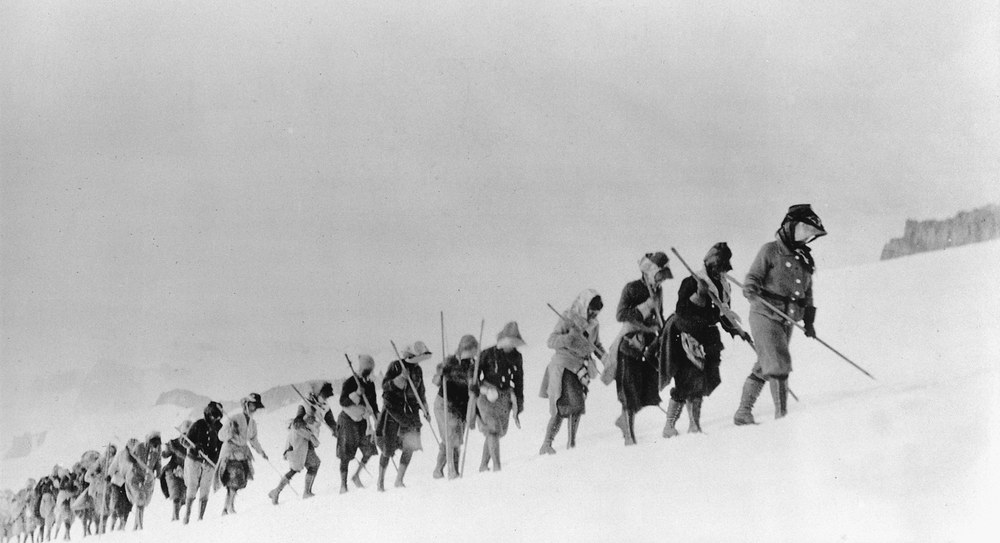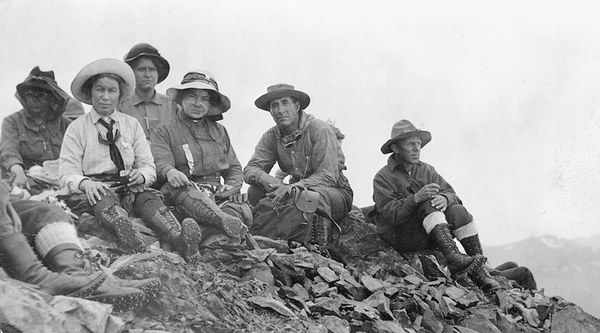
The Spanish Flu swept the globe in 1918, just over 100 years ago. While we could find little reference of how this impacted Mountaineers at the time, we’re watching as a similar pandemic grinds our spring and summer plans to a halt. At the time of writing, the Stay Home, Stay Safe order is still in place, and we don’t know how and when getting outside will return to ’normal.’ So for this Retro Rewind, we decided to look back one century ago at the summer excursion of 1920, to see just what Mountaineers members were up to and find inspiration in their intrepid spirits.
A quick history
The idea for The Mountaineers was conceived, fittingly, on a mountain in 1906, and by 1907 we had 233 members in our ranks. The highlight of every year was the summer outing, where often more than 100 members would spend 2-3 weeks tramping in areas of Washington previously unexplored by settlers.
“Summer outings were massive undertakings,” wrote Jim Kjeldson in The Mountaineers: A History. “Activities on these outings were as varied as the members’ interests, but almost always included a climb of a major peak, naturalist walks, and photography, as well as shorter, easier climbs and walks in the vicinity of the base camp. Until a separate climbing course was set up in 1935, the summer outing also was where the club’s mountaineering instruction took place.”
The logistics of supplying food and equipment was the largest challenge, especially since the summer outings were often set in locations with little access roads or trails. Group supplies like tents, cookware, and food was managed as a group, and each participant as allowed only a thirty-pound cylindrical canvas bag of personal items. The only clothing available at the time was heavy, bulky wool clothing, and members needed to pack enough to stay warm while adhering to strict clothing requirements.
“The idea of maintaining a dress code in the mountains may seem a bit silly today, but in the early days it was a fact of life. It would be years before women were permitted to wear pants on outings without causing a scandal,” wrote Kjeldson. “Men were advised to have ‘one tramping suit of some good, stout material such as denim, khaki, or corduroy. Women should have one durable waist (blouse) for tramping, and one to wear around camp. The skirt should be short, not much below the knees, and under it should be worn bloomers.’ [Women] were expected to wear their long skirts in camp and to change for the climb to shorter skirts worn over wool serge bloomers – uncomfortably hot garb for a summer climb.”
Sun protection was another big consideration for the summer outings. Everyone was advised to wear colored glasses, and men painted their faces in greasepaint to protect from the UV rays. Women donned heavy veils, which cascaded around their faces from large hats.
 On the summit of Mount Olympus during the 1913 outing: Winona Bailey, H. May Baptie, Grace Howard, Lulie Nettleton, P. M. McGregor, and L. A. Nelson. All had been on the first 1907 summer outing to the Olympics. Photo by P. M. McGregor, courtesy of Special Collections, University of Washington Libraries neg. no. 18159.
On the summit of Mount Olympus during the 1913 outing: Winona Bailey, H. May Baptie, Grace Howard, Lulie Nettleton, P. M. McGregor, and L. A. Nelson. All had been on the first 1907 summer outing to the Olympics. Photo by P. M. McGregor, courtesy of Special Collections, University of Washington Libraries neg. no. 18159.
1920: To the Olympics
For the 1920 summer outing, eighty Mountaineers set out of Seattle on July 31 by boat for a three week excursion into the Olympic Mountains. The boat dropped the adventurers on Hood Canal in Brinnon, WA. From there, the plan was to hike deep into the Olympics, stay at a variety of camps along the way, climb the nearby peaks, and finish in Moclips, WA, where they’d catch a train back to Seattle.
“Nobody thought there could be three weeks of continuous sunshine in the Olympics, but there was – almost, all but one sad day,” wrote Winona Bailey, a member of the 1920 outing committee and a member on the Board of Trustees. She wrote the summer outing trip report for The Mountaineers Annual of 1920.
Like all summer outings, the logistics of this trip were challenging and had to be perfectly coordinated. Planning began years in advance. Large group organization in military fashion worked best for safety and security. To carry food and supplies into the Olympics, Mountaineers used packhorses with designated packers in charge for different legs of the journey. These packers were responsible for packing and leading the horses, which carried most of the equipment.
Organizers planned campsites, and scouting groups went out in advance to cache multiple tons of food in the chosen camping areas. Over the three week trip members would work their way between camps, sometimes staying longer at some sites than others depending on their individual objectives, and each camp needed to be set up and stocked. The scouts were also responsible for cleaning up any windfall. Luckily, many of the trails had just been completed the previous spring and summer as the Forest Service was getting back up to speed post WWI, so not a lot of resistance was met.
During the day and sometimes overnight, teams as small as twelve to as large as fifty broke off to climb different peaks and explore areas of the range where club members had yet to wander. Like most Mountaineers, Winona didn’t go on every climb, but she was successful on two summits: Claywood and Sentinel. In fact, no member of the 1920 outing climbed all of the ten peaks attempted. The most summits by a single member was eight, completed by Phillip Rogers, Jr.
Of the Mt. Olympus outing, Effie Chapman wrote in the annual, “We came at last to the base of the Middle Peak of Mount Olympus and tackled the last steep snow slope and the rock above - much more of the latter than on the East Peak climbed by The Mountaineers in 1913. By 4.30 p.m. forty-five of the party stood on the summit taking in the countless ridges and peaks that constitute the Olympic group.”
Returning from the day’s adventure, individuals relaxed in relative luxury, especially in comparison to the lightweight bivys many of us call home in the backcountry today. After the Olympus climb, the group was greeted with treats normally only found on holidays, in the comfiest settings. “We returned to main camp with its luxuries and a bountiful dinner including huckleberry and apple pies. Rice, raisins, cocoa and the service that accompanied them were surely never so appreciated.”
“Be it said that in spite of uninterrupted days of travel and the roughness of Olympic trails, not a single night did dunnage fail to arrive before dark and not once was dinner served by candle-light because of a tardy pack-train,” wrote Winona.
Into the boats!
While the successful climbs were memorable, no summit could match the excitement of the Quinault canoe trip that served as a climax and ended their time in the Olympics. The canoe trip took Mountaineers down the river, all the way from Lake Quinault to the Pacific Coast. There, from Taholah, they only had a few miles of beach travel to reach Moclips.
A dozen canoes had been towed in on two lines across the lake. Once cut loose, they swung into the swift current of the river where paddlers encountered every condition imaginable. “The lap of paddle in clear deep water, the scraping of boat and pole over rocks, the noise of rapids ahead, the dark-outstanding rocks avoided, the swaying branches from ever verdant banks, the low bridge of log-jam, the narrow passage with no space to spare above or at the side, the Siwash illahee in lonely spot among the trees, finally the deep black water, the 'distant roar of ocean, the Indian village Taholah, the blood-red sun sinking into the waters of the Pacific; such was the close of the 1920 outing.”
Adventuring has changed a bit over the past 100 years, but that doesn’t mean its value has. If The Mountaineers of yesteryear could enjoy a fantastic adventure on the heels WW1 and the Spanish Flu, our community today can find ways to get back to all of the things we love. Who knows, maybe right now you’re reading this from the comfort of your favorite sleeping bag.
 Mapped route of The Mountaineers 1920 Summer Excursion. Photo from The Mountaineers 1920 Annual.
Mapped route of The Mountaineers 1920 Summer Excursion. Photo from The Mountaineers 1920 Annual.
MAIN IMAGE OF The Mountaineers “all in a line” on Glacier Peak during the 1910 summer outing. The original caption notes: “Puzzle: Find the women - They are all women.” Photo by H. A. Fuller, Charles Albertson Photo Album, The Mountaineers Archives.
This article originally appeared in our Summer 2020 issue of Mountaineer Magazine. To view the original article in magazine form and read more stories from our publication, visit our magazine archive.
 Trevor Dickie
Trevor Dickie